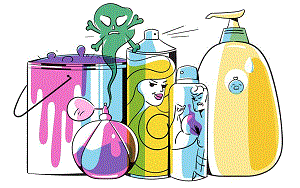
You can see these really rapid decreases in tailpipe emissions, said Brian C. McDonald, a scientist at the Cooperative Institute for Research in Environmental Science at the University of Colorado, Boulder, who led the study. It just made sense to start looking at other sources and seeing whether they could be growing in relative importance. While people use far more fuel, by weight, than they do lotions and paints, Dr. McDonald and his colleagues found a marked difference in how much of the pollutants from those products end up in the air.
Even though drivers can use gallons of gasoline each week, its stored in an airtight tank, its burned for energy, and converted mostly to carbon dioxide, said Jessica B. Gilman, a research chemist at the National Oceanic and Atmospheric Administration also involved in the study. Those carbon dioxide emissions are not smog-forming VOCs, though they are a major driver of human-caused climate change. But these VOCs that you use in everyday productseven though it may just be a teaspoon or a squirt or a spraythe majority of those kinds of compounds will ultimately end up in the atmosphere, where they can react and contribute to both harmful ozone formation and small-particle formation, Dr. Gilman said. 40% of the chemicals added to consumer products wind up in the air, the researchers found.
California has regulated emissions from consumer products since the late 1980s, and federal regulations have followed suit, setting VOC emissions limits for a range of items, including paints, varnishes and lacquers.
Concerned consumers may be tempted to turn to natural products, though the researchers say that isnt a cure-all. For example, one class of compounds called terpenes gives many cleaning products a pine or citrus smell. These terpenes can be produced synthetically, or naturally from oranges.
But whether its synthetic or natural, once it gets into the atmosphere its incredibly reactive, Dr. Gilman said. Similar natural compounds give the Blue Ridge Mountains in Appalachia their name, from the blue haze formed by terpenes emitted from the trees there, Dr. Gilman added.
Galina Churkina, a research fellow at the Yale School of Forestry and Environmental Studies who was not involved in the study, noted that the study did not consider emissions related to biological sources like trees and animals. But the authors said their study was not the end of this line of research.
There are tens of thousands of chemicals in consumer products, and researchers have not yet pinpointed which chemicals are most likely to form ozone or PM2.5 particles. One of the things that were hoping the public takes away from this is that our energy sources and the consumer products we use every day are continually changing the composition of our atmosphere, Dr. Gilman said. Notably, some of the VOCs used in consumer products were replacements for chlorofluorocarbons, or CFCs. Those chemicals were phased out beginning in the 1980s because they thinned the Earths ozone layer.
For consumers looking for a greener solution, Dr. McDonald offered some advice. Use as little of the product as you can to get the job done, he said.
Pierre-Louis, Kendra and Hiroko Tabuchi, Want Cleaner Air? Try Using Less Deodorant, nytimes.com/2018/02/16/climate/perfume-pollution-smog.html, February 16, 2018


